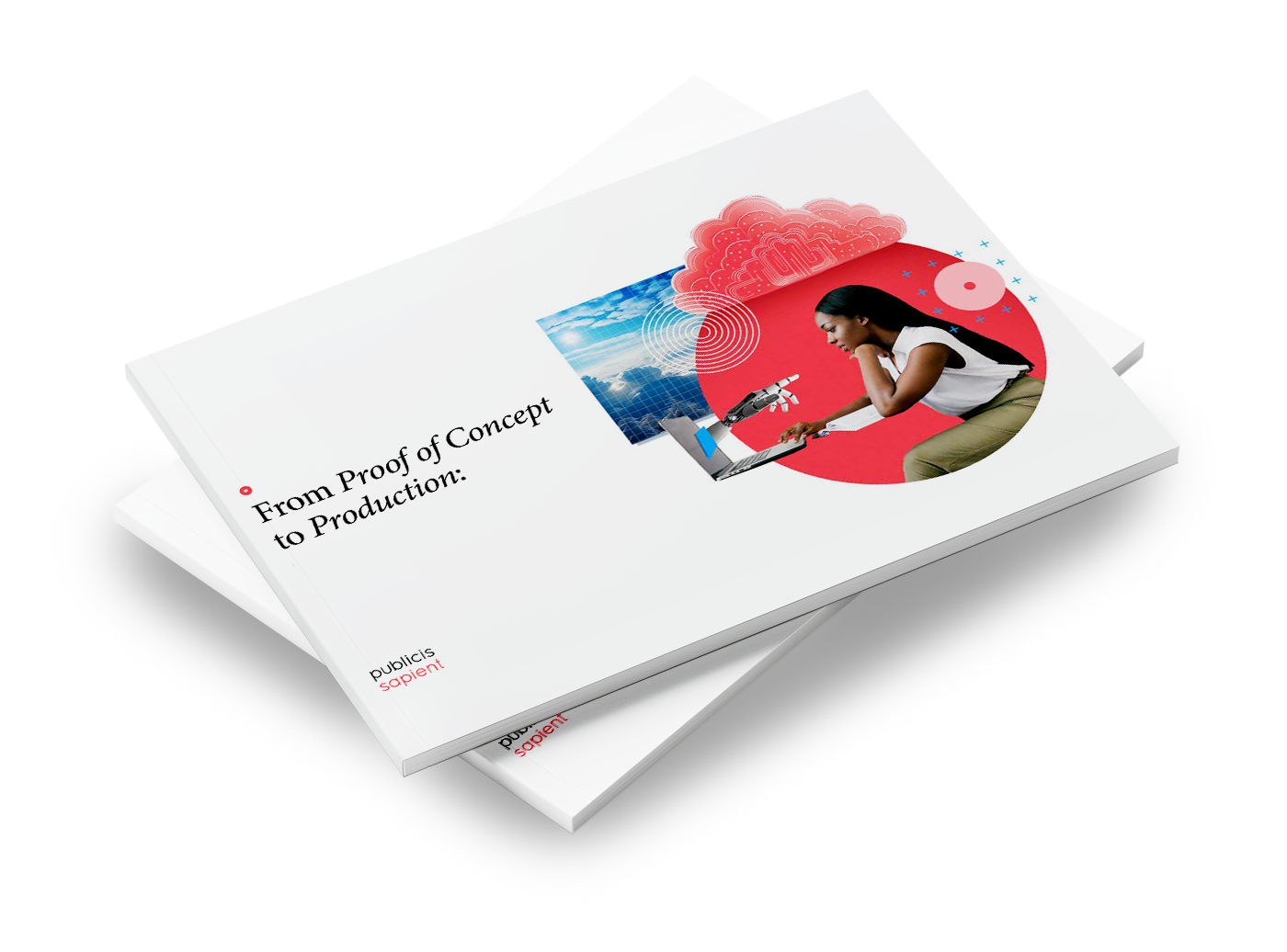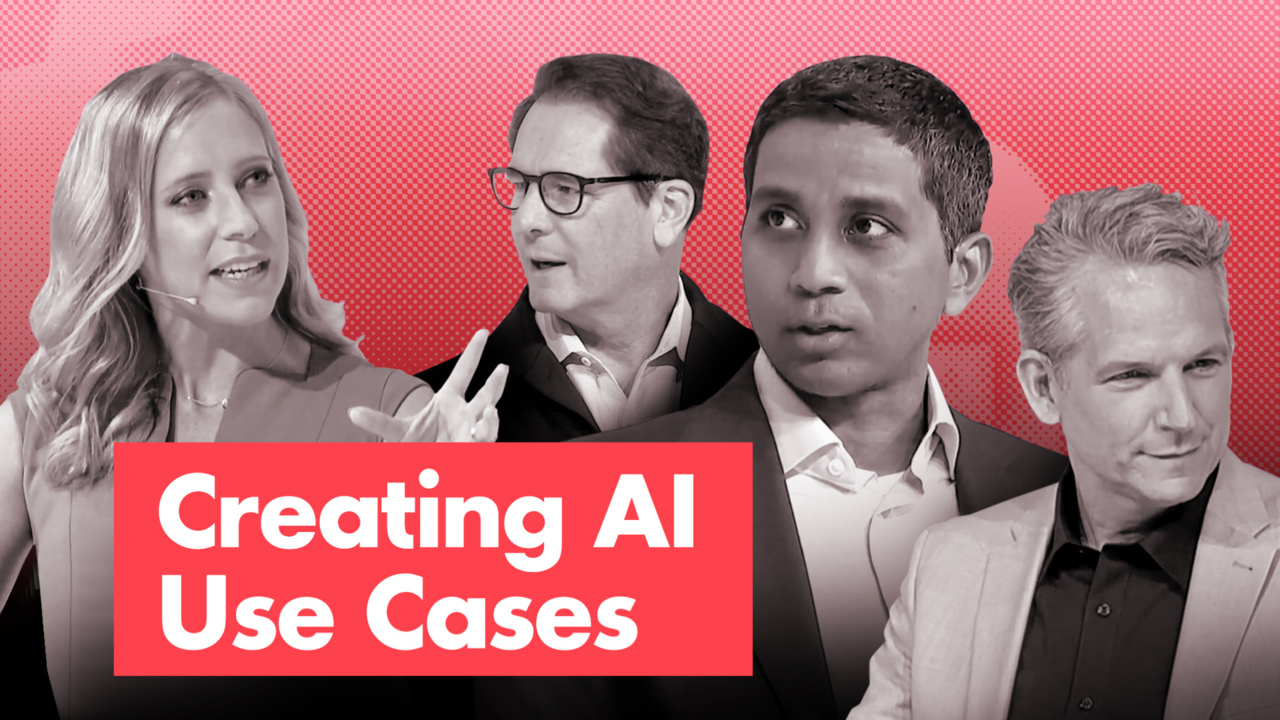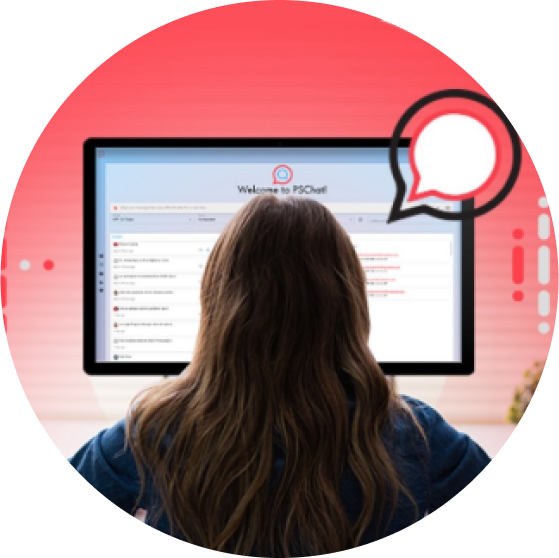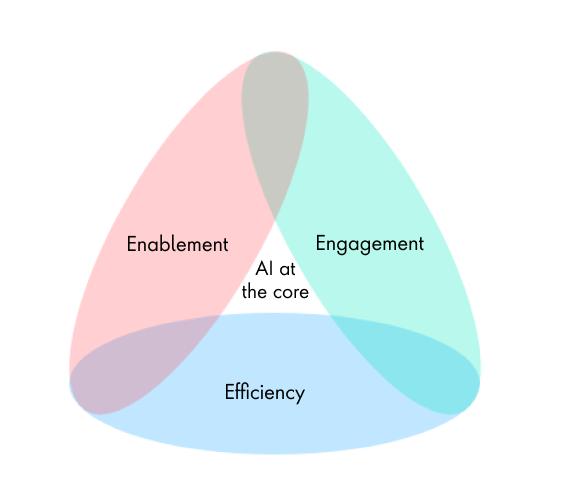Businesses have raced to harness the power of generative artificial intelligence (AI) to drive future organizational impact. The spotlight has largely focused on:
What issue can we solve for you?
Type in your prompt above or try one of these suggestions
Suggested Prompt


-

Efficiency
Using generative AI to turbocharge productivity and slash operational costs

Engagement
Using generative AI to craft a better experience for customers through personalization, quick and effective customer service and virtual advisers/shopping assistants
However, a largely untapped area remains: organization enablement. As a strategic co-pilot, generative AI can enable businesses to unlock their full potential in two ways:
- Empowering business decision-making at the core
- Unleashing creativity for employees
Why should companies utilize generative AI for business transformation?
For companies, generative AI (and AI at large) is the next stage in the digital revolution, one that saw digitally native organizations disrupt age-old established businesses. As long-standing companies were slow to adopt digital or believed that digital processes were merely “add-ons” to their overall strategy, digitally native organizations used their tech DNA to differentiate themselves and gain a competitive advantage.
AI and generative AI will have a similar impact as organizations incorporate it at different paces and levels. The organizations that transform into “AI-native” entities—those that utilize AI at the heart of their business and integrate AI into decision-making processes and functions—will be well-equipped to differentiate themselves from those that utilize AI solely for efficiency, engagement or both.
Figure 1: Organizations with AI at the core can benefit from the three E’s of generative AI

Stuck in the generative AI prototype phase?
Most generative AI projects stall before launch. This guide reveals how to overcome common challenges and get your prototypes to production faster.
How can businesses adopt generative AI at the core?
Leaders must first understand the full potential of generative AI and what their business can gain from it. They should build a narrative on the value AI will bring that is compelling enough to gain company alignment. Next, they must build a strategy around generative AI and integrate it into business functions for decision-making.
Generative AI can quickly analyze information and provide valuable insights by:
- Leveraging market trends, customer behavior and sales forecasting to plan campaigns and prioritize resources
- Simulating business scenarios so that leaders can make appropriate decisions based on shifting needs and priorities
- Analyzing employee feedback/sentiment to help leaders quickly identify operational areas that are strong and those that need improvement
- Helping build an empowered workforce
What is generative AI’s impact on employee creativity?
A fully integrated AI strategy at the heart of operations and processes fuels employee creativity in their day-to-day work. It reduces mundane tasks and give employees the ability to focus on problem-solving opportunities.
Such creative gains are only possible when businesses equip their employees with the right tools. As a tool that generates new content, generative AI supports labor at all stages of creative production, including ideation, first drafts, mock-ups and even final proofing.
Yet no matter the production stage, the result is the same: Generative AI does not displace employees’ labor; it helps them complete assignments faster. By reducing the time it takes for employees to complete creative tasks, generative AI gives them more time to take on new ones. Ultimately, this enhanced, scalable efficiency helps AI-optimized businesses gain a competitive advantage.
How businesses can experiment with AI

Publicis Sapient CEO Nigel Vaz explains how generative AI accelerates innovation
What should companies keep in mind when considering generative AI platforms and tools for employees?
When incorporating generative AI tools into the core of the business, organizations must weigh certain considerations to ensure security, safety and creativity. Generative AI operates by learning from previous content and data and creating something new from it. As a result, users take a risk by inputting confidential content into platforms and tools that will use it to grow.
What can organizations do to enhance security and protect their information? They can design and implement standalone versions of these tools with guardrails that ensure data does not leave the organization. This accomplishes two things:
- It protects proprietary information and prevents external organizations from using or monetizing it.
- It allows employees the freedom to leverage generative AI tools in their day-to-day work without fear of inadvertently leaking confidential data.

How Publicis Sapient puts generative AI in the hands of every employee
Publicis Sapient has been a trailblazer in the development of company-specific generative AI tools by creating “PSChat” and making it available to the whole organization. PSChat utilizes not only publicly available content but also internal, non-confidential company assets. It gives employees a sandbox in which they have the freedom to ideate in a secure environment and unlock efficiency in their everyday work.
Companies should also consider the many ethical concerns surrounding generative AI. As a new, unregulated tool, generative AI has the potential to cause harm to individuals and organizations alike—such as by creating and spreading misinformation, promoting biases and fostering plagiarism—if not leveraged ethically.
Since businesses cannot rely on slow-moving, imperfect regulations to safeguard against the risks and potential misuse of generative AI, they must set up strong governance processes and robust ethical and risk management frameworks. These frameworks will encourage the responsible, safe and secure use of generative AI within the organization. They will also give companies an opportunity to put their unique values into practice.
Figure 2: Ethical and risk management frameworks should shape generative AI
Building toward the future
With the right tools, businesses have the ability to generate and nurture quality ideas from within the organization itself. Generative AI can help amplify and harness an organization’s full potential to boost its competitive advantage and ultimately lead it to become a disruptor in its field.
Whether it helps employees complete simple tasks like quickly responding to customer service inquiries or supports C-suite leaders as a strategic decision-making ally, generative AI has something for everyone. It enables efficiency in everyday work, fuels experimentation and uncovers innovative ways to meet and exceed an organization’s goals. As a digital business transformation partner, Publicis Sapient helps organizations get the most out of generative AI to differentiate themselves and stay competitive in a crowded landscape.
Related Reading
-
![]()
Insight
6 Things Every CEO Should Know About Generative AI
With generative AI, businesses have new ways to utilize data and solve problems. Learn what CEOs need to consider to best leverage gen AI for their company.
-
![]()
Insight
How generative AI will revolutionize your business
Businesses can use generative AI to enhance workflows rather than replace human roles—with a more human-AI collaboration in mind.
-
![]()
Insight
What is Generative AI: From Now to Next
Generative AI is a type of artificial intelligence that is capable of creating new content, like images. How does it work, and how can business benefit?











